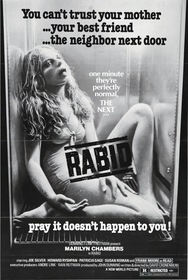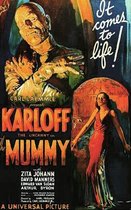Our editor-in-chief Nate Yapp is proud to have contributed to the new book Hidden Horror: A Celebration of 101 Underrated and Overlooked Fright Flicks, edited by Aaron Christensen. Another contributors include Anthony Timpone, B.J. Colangelo, Dave Alexander, Classic-Horror.com's own Robert C. Ring and John W. Bowen. Pick up a copy today from Amazon.com!
Rabid (1977)
Before ascending to Hollywood's A-list, Canadian writer-director David Cronenberg, much like Sam Raimi or Peter Jackson, started out making low-budget horror movies. After a strong debut with the slug-centric Shivers (1975), he crafted Rabid (1977), an unconventional vampire film that showcased his distinct aesthetic signature, which includes disturbing, highly memorable visuals that depict deformed human flesh, body transformation and/or mutation, bodily fluids, disease and a plethora of symbolic sexual imagery. The strength of the director's sophomore effort lies in his ability to use these unnerving visuals to not only frighten his audience, but to also express deeper themes and ideas within the story. Largely, he accomplishes this through Rose, the film's protagonist.
After narrowly surviving a motorcycle explosion, young Rose (Marilyn Chambers) becomes a test subject for a new, experimental method of plastic surgery. The operation successfully repairs her skin damage, but leaves a nasty side effect - newly grown mutated skin tissue that allows her to survive only by drinking human blood. Horrified, Rose escapes from the hospital to find her boyfriend Hart (Frank Moore), feeding on hapless strangers on the way to satiate her appetite. Unknowingly, she infects those she drains with a new kind of virus akin to rabies, transforming them into contagious, uncontrollable man-eating monsters. As an epidemic spreads across the country, will Rose and Hart find each other before "the rabid" find them first?
As I mentioned earlier, Marilyn Chambers' Rose is the key to Rabid's expression of terror and ideas. Whenever she visibly drains a victim on screen, Cronenberg creates visually powerful and horrifyingly original imagery with disturbing sexual connotations: instead of biting a victim on the neck like a traditional vampire, Rose stabs him with a pair of phallic-shaped stingers that protrude from inside vaginal-like orifices beneath her armpits and suck out his blood. The camera more than once displays lingering shots of her new mutant organs in extreme close-up, creating a sense of unease and dread. Her every scene also becomes tense and suspenseful, as the viewer never knows if or when exactly she will give into her urges and claim another victim.
At the same time, her feeding method is a direct metaphor for sex, as she essentially penetrates her prey with a new body part that symbolically amalgamates both male and female sexual organs and nearly every scene where she feeds has obvious sexual undertones. For example, the first person she drains is another patient. Nude from the top down, Rose claims she feels cold and hugs the man tightly, begging him to warm her. The patient seems to enjoy her tight arousing embrace, until suddenly, he begins to bleed profusely at the points where her arms meet his body, while Rose writhes and moans in pleasure. Later in the film, she wanders the streets of a city like a prostitute searching for a trick, and uses her charms to lure men - potential meals - to her.
Whenever Rose does give in to her urges, she infects her victim with a virus, which sooner or later turns him/her into a "rabid." Cronenberg thus expresses a critique of unrestrained sexual intercourse, directly linking it with sickness. The director's thinking was ahead of its time, as he established this theme of "sexual disease" in Rabid over a decade before AIDS hit the public consciousness.
Rose's infected offspring, "the rabid," complement her role in several ways. While Rose retains her humanity and intelligence and feeds only when she needs to, the rabid act on pure instinct, violently and savagely attacking and eating -- the good old-fashioned way -- anyone in sight without second thought. Whereas Rose's actions create suspenseful terror, the rabid provide effective shock value - when an infected doctor snips off a nurse's finger with scissors during an operation before biting into the bleeding stem, the viewer is bound to get a good jolt.
The rabid are closer to zombies than vampires -- they ultimately have no intelligence, no identity and no character. The only thing they exist for is to consume others. Therefore, we can read them as a metaphor for endless consumption. If Cronenberg uses Rose to critique unrestrained sex, then through the rabid, he appears to comment on mass consumerism. That Cronenberg is able to pull of all these ideas visually shows what an already talented director he was when he made his second feature. However, he falters considerably as a screenwriter.
The narrative has several gaping holes, such as the lack of any real explanation as to how exactly Rose's operation gave her new appendages or why conveniently, everyone she drains of blood seems to immediately forget what just happened to them. He also wants us to sympathize with Rose by making her a victim of a scientific experiment, but his idea doesn't work out too well, as he never acquaints us with the person she used to be prior to becoming a vampire. The most we see of her "humanity" is that she struggles a little against her urges, but then ultimately gives into them, feeling little to no remorse for any of her victims. As such, Rose is highly unsympathetic and her ultimate fate lacks any real dramatic resonance.
Overall, Rabid is a mixed bag. Cronenberg's handling of story and character is subpar, but his visuals and his ideas hold up quite well, making Rabid not just scary, but deeper and more intelligent than a typical vampire film. Fans of his work should pick it up, as it provides a look into Cronenberg's oeuvre before he helmed more sophisticated horror films like Videodrome and The Fly. It's also for anyone that likes thought-provoking horror films that offer more than just gore and terror. Recommended.








